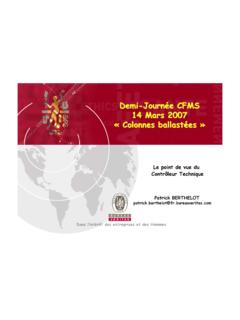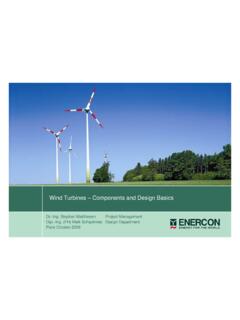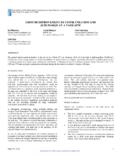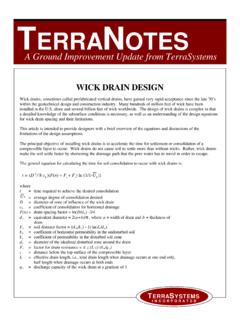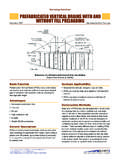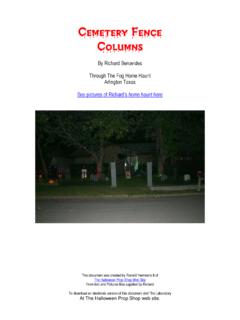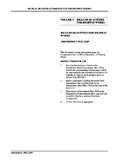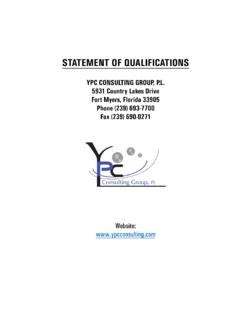Transcription of RECOMMENDATIONS FOR THE DESIGN, CALCULATION, …
1 RECOMMENDATIONS FOR THE design , calculation , construction AND QUALITY CONTROL OF STONE columns UNDER BUILDINGS AND SENSITIVE STRUCTURES Version No. 2 - March 16, 2011 1 of 32 Forward:This report is a new and revised version of the RECOMMENDATIONS published in the RFG No. 111 in 2005. It takes into account both the experimental results and observations of the French "Union Syndicale G otechnique" (USG) in the interest of better understanding soil-structure interactions. This version also includes chapters on design based on laboratory and cone penetration tests (CPT). It presents the guidelines to be followed by all building contractors in France (according to Article R111-40 of the French Building and Residential construction Rules) and oversight entities dealing with the design , calculation , installation and quality control of stone columns and their interaction with buildings and settlement-sensitive structures.
2 The following participated in drafting this document: P. Aguado (Apave) P. Berthelot (Bureau Veritas) L. Carpinteiro (Socotec) F. Durand (Fugro Geotechnique) M. Glandy (Soletanche Bachy Pieux) P. Liausu (Menard) B. Pezot (Menard) C. Poilpre (consultant) S. Lambert (Keller Fondations Speciales) J. P. Volcke (Franki Fondation) G. Billoet (Keller Fondations Sp ciales) and J. R. Gauthey (Spie Fondations) also participated in discussions. This document has been approved by the Union Syndicale G otechnique (USG, the French geotechnical union association) and the Comit Fran ais de M canique des Sols (CFMS, the French society for soil mechanics, ISSMGE member society). RECOMMENDATIONS FOR THE design , calculation , construction AND QUALITY CONTROL OF STONE columns UNDER BUILDINGS AND SENSITIVE STRUCTURES Version No.
3 2 - March 16, 2011 2 of 32 CONTENTS 1 INTRODUCTION .. 4 2 FIELDS OF 5 By type of structure .. 5 Use in seismic zones .. 5 Limitations of 5 6 Methods and materials .. 6 Pre-drilling .. 6 Gravel 6 4 construction PROVISIONS .. 7 Diameter of stone 7 Interface between the treated soil and the building structure .. 7 Installation of footings and raft foundations .. 8 Installation of a load transfer platform .. 8 Configuration of stone columns .. 9 Structures with uniform distributed loads .. 9 Isolated and strip 9 Maximum reference grids: .. 10 Minimum reference grids: .. 10 Stone columns under an embankment supporting a foundation .. 11 Tolerances .. 11 columns in grid networks.
4 11 columns under footings .. 11 Reduction factor for the volumes of material used .. 12 5 design .. 12 Prerequisite information needed for 12 Criteria for determining column size .. 12 Hypotheses .. 13 Maximum allowable stress for stone columns .. 14 Bulging 14 General shear failure .. 15 RECOMMENDATIONS FOR THE design , calculation , construction AND QUALITY CONTROL OF STONE columns UNDER BUILDINGS AND SENSITIVE STRUCTURES Version No. 2 - March 16, 2011 3 of 32 Punching effect shear 15 Stresses within the columns .. 16 Evaluating stress and settlement at the service limit state (SLS) .. 16 Homogenization method for concrete slabs and raft foundations subject to uniform, infinite 17 columns under footings with vertical and centered load bearing.
5 19 Stresses other than vertical centered loads .. 21 Simplified method .. 22 Other methods .. 23 Special provisions for embankments (uniform load) .. 24 Other evaluation 24 Numerical finite element approach .. 24 Homogenization 25 Possible effects on structural 25 Concrete slabs on a load transfer 25 Footing or raft foundation with or without a load transfer platform .. 26 6 QUALITY CONTROL AND ACCEPTANCE .. 26 Quality control during installation .. 26 Calibration 26 Informational 26 26 Acceptance tests .. 27 Test Frequency .. 27 Diameter 27 Checking continuity .. 27 Compaction verification.
6 27 Load test .. 28 30 APPENDIX I STANDARD CONFIGURATIONS FOR STONE columns UNDER FOUNDATION FOOTINGS .. 31 RECOMMENDATIONS FOR THE design , calculation , construction AND QUALITY CONTROL OF STONE columns UNDER BUILDINGS AND SENSITIVE STRUCTURES Version No. 2 - March 16, 2011 4 of 32 1 INTRODUCTION(1) The columns referred to in these guidelines are vertical piles made of cohesionless granular materials that are driven into the soil and then compacted by repetitive action. Comment #1:These columns do not contain any particular type of binder at any level. In this document, the term stone column is limited to the definition above. (2) The columns can be constructed in regular or variable grids in rows or groups, or even in isolation. (3) Their design takes into account the type of structure to be built, the kind of load, tolerances, and requirements regarding absolute and differential settlement, as well as the nature and characteristics of the soil to be treated.
7 (4) The purpose of stone columns is to give the soil under the structure to be built new general and/or local characteristics so that the structure s various infrastructure elements (isolated or strip footing, raft foundations, concrete slabs, embankments, etc.) will demonstrate predictable and justifiable behavior consistent with the regulations and tolerances that apply to the structure of the building and its intended use. (5) Treating soil with stone columns involves a combination of the following actions, of which one or more may be intended: Improving bearing capacity Reducing settlement Improving uniformity of geotechnical characteristics Increasing the consolidation rate by creating drainage elements Increasing equivalent ground mass characteristics (horizontal shear strength, angle of internal friction and deformation parameters).
8 (6) A stone column is a soil improvement measure. It is neither a foundation element, nor a deep foundation element. (7) The foundation of a structure built on soil treated by stone columns is always superficial (isolated or strip footing, raft foundations, concrete slabs, etc.). It can also be part of the foundation of an embankment. (8) The objective is to control the behavior of these structures, and in particular to reduce the settlement. Comment #1:Depending on the existing grid density and geotechnical conditions, this coefficient is usually between and 4 under distributed loads. (9) The need for soil treatment should be analyzed by the project s geotechnical engineer, who should provide and approve the calculation hypotheses.
9 Comment #2:A reminder: the stone column geotechnical study should examine not only the soil to be treated, but any soil that could potentially settle under the treated layer. Comment #3:The contractor must involve the geotechnical engineer in the design and the execution of the project in compliance with standard NF P 94-500 concerning geotechnical procedures in France. RECOMMENDATIONS FOR THE design , calculation , construction AND QUALITY CONTROL OF STONE columns UNDER BUILDINGS AND SENSITIVE STRUCTURES Version No. 2 - March 16, 2011 5 of 32 2 FIELDS OF By type of structure(1) The most common uses of stone column treatment involve structures with concrete slabs or raft foundations with surface loads sensitive to settlement: Hangars and warehouses Industrial and commercial buildings Silos and tanks of all kinds Watertight hydraulic structures (tanks, sewage treatment plants, etc.)
10 (2) By extension, they can be used under other types of structures, too, as long as the residual deformations of the treated soil and underlying layers are consistent with the structure in question and with associated technical measures: On-shore civil engineering works (roads, embankments, bridges, retaining walls), and maritime structures (seabed, lake and riverbed reinforcement), Under shallow building foundations. (3) They can also be used for stable heterogeneous embankments where systematic treatment with an appropriate and regular grid can help improve and/or homogenize the soil characteristics to make it suitable for surface construction . Use in seismic zones(1) It is also possible to use stone columns in seismic zones where they may reduce the risk of soil liquefaction and increase shear resistance.
